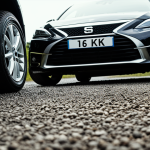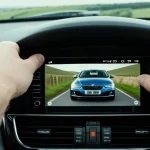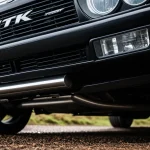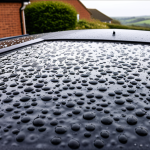Understanding UV Damage to British Car Paint
Ultraviolet (UV) rays impact British car paint by penetrating and breaking down the multiple layers that protect a vehicle’s finish. The paint fading and paint degradation occur primarily because UV rays damage both the pigmented base coat and the clear coat that shields it. This breakdown leads to oxidation, where the paint loses its vibrancy and becomes dull.
Common signs of this UV-induced damage include visible fading, where the original glossy color appears washed out, and oxidation, characterized by a chalky texture on the surface. In more severe cases, blistering or cracking may develop, signaling the degradation of the clear coat’s protective barrier.
This might interest you : Ultimate Guide to Boosting Soundproofing in Your British Family Car: Key Tips for a Quieter Ride
British cars often have particular vulnerabilities in their paint types and finishes. For instance, many classic British marques use softer paints that are more susceptible to UV damage than modern counterparts. Additionally, specialized finishes found on these vehicles can degrade faster if not properly protected, accelerating paint fading and loss of luster. Understanding these unique susceptibilities is critical for selecting effective protective strategies tailored to British car paint.
Essential Preventative Measures for UV Protection
Regular waxing is a fundamental protective technique against UV damage to British car paint. Wax forms a sacrificial barrier that absorbs and reflects UV rays, reducing the direct impact on the paint surface. Applying wax every few months provides ongoing UV shielding, helping to maintain a vibrant finish and slow down the paint fading process.
Have you seen this : Comprehensive Waterproofing and Sealing Strategies for Your British Convertible Roof: Key Tips for Enduring Protection
Synthetic paint sealants offer longer-lasting protection compared to natural waxes. Unlike traditional wax, sealants create a tougher, more durable shield against UV ray effects on British car paint. Sealants can remain effective for six months to a year, making them a practical choice for owners seeking extended paint degradation prevention without frequent reapplication.
Tailored car covers designed specifically for British vehicles provide another layer of defense. These covers protect against harmful rays when cars are parked outdoors for extended periods. Choosing materials with UV-resistant properties not only guards the paint from fading but also prevents oxidation and potential blistering caused by sun exposure. Utilizing proper car covers complements waxing and sealants, creating a comprehensive defense system to preserve British car paint quality.
Recommended Products for Safeguarding Your British Car’s Paint
Selecting the best car wax for UV protection is essential to counteract the damaging UV ray effects on British car paint. High-quality waxes designed with specialized UV blockers help maintain the paint’s vibrancy and prevent paint fading. Popular options often include synthetic formulations enriched with UV inhibitors that offer longer-lasting protection than traditional natural waxes. These products form a robust shield against paint degradation by reflecting harmful rays and minimizing oxidation.
When choosing UV blocking sealants, it is important to consider durability and ease of application. Sealants that bond chemically with the paint surface provide extended protection, often lasting from six months to over a year. This durability is particularly beneficial for British cars with softer finishes prone to quicker degradation. Sealants equipped with advanced UV-resistant compounds create a tougher barrier than wax, enhancing resistance against fading, oxidation, and clear coat blistering.
For outdoor storage or extended parking, investing in a high-quality car cover is also crucial. The best covers for British vehicles incorporate materials rated for UV resistance, blocking nearly all harmful rays while allowing breathability to prevent moisture buildup. Comparing different options reveals that tailored covers, designed to fit British car models precisely, better protect sensitive paint finishes by reducing friction and ensuring full coverage. These covers complement wax and sealant protection by guarding against additional environmental stressors that accelerate paint fading and degradation.
Expert user reviews often highlight the synergy between these products. Regular waxing combined with durable UV sealants and tailored car covers forms a comprehensive defense system that preserves British car paint quality, slows deterioration, and keeps the finish looking showroom fresh despite frequent sun exposure.
Unique Considerations for British Cars
British car paint often exhibits distinct vulnerabilities due to its unique formulations and historic finish techniques. Many classic British marques employed softer paint compounds that, while providing rich colors and depth, lack the robust UV resistance found in modern automotive paints. This softness increases the risk of paint fading and paint degradation when exposed to UV rays, as the protective clear coat can deteriorate more rapidly, permitting oxidation and blistering underneath.
Preserving original paint on vintage British vehicles is particularly challenging. Unlike repainted surfaces, original finishes may have aged unevenly and lost some resilience over decades. Careful restoration and maintenance tailored to these classic car paint characteristics are essential to slow further degradation. Using products specifically designed for delicate finishes with gentle yet effective UV ray effects on British car paint protection is recommended to maintain authenticity while enhancing durability.
Furthermore, British automotive restoration demands awareness of how paint layers interact with environmental UV exposure. Soft paints on British cars often require more frequent application of wax or advanced sealants to reinforce the weakened clear coat. For enthusiasts and professionals, understanding these specific weaknesses ensures that routine care strategies prevent lasting damage and uphold the vehicle’s value and appearance.
Step-by-Step Procedures for Applying UV Protection
Applying UV protection correctly is crucial to safeguarding British car paint from paint fading and paint degradation. The process begins with thorough cleaning. Start by washing the vehicle using a pH-balanced automotive shampoo to remove dirt, grime, and old wax residue. This ensures the surface is free of contaminants, allowing protective products to bond effectively.
After washing, dry the car completely to prevent water spots. Next, inspect the paint for any oxidation or minor imperfections and consider using a clay bar treatment to eliminate embedded particles that might interfere with the product’s adherence. Preparing the paint surface properly maximizes the effectiveness of your protective techniques.
When applying car wax, use a soft applicator pad to spread a thin, even layer across small sections of the paint. Circular motions help achieve thorough coverage. Allow the wax to haze according to manufacturer instructions before gently buffing it off with a clean microfiber cloth. This method seals the paint with a sacrificial UV barrier, helping to slow down paint fading caused by UV ray effects on British car paint.
For synthetic paint sealants, the application is similar but with slight differences. Apply the sealant in thin layers, ensuring the product bonds chemically with the surface. These sealants require curing time—usually 20 to 30 minutes—before buffing, forming a stronger and longer-lasting shield against UV damage and oxidation. Frequently, multiple layers enhance protection, especially for vulnerable British car paints.
To avoid streaks or residue, applying products in shaded areas and on cool surfaces prevents premature drying. Consistent, gentle motions and small application sections prevent uneven coverage. Following manufacturer guidelines precisely yields the best results, ensuring your protective layer is both durable and effective.
By adhering to these step-by-step car waxing and sealant instructions, British car owners can maintain the finish’s vibrancy and significantly delay paint degradation, even under prolonged sun exposure.
Maintenance Routines for Lasting UV Protection
Maintaining effective UV protection on British car paint requires a consistent routine care schedule to prevent paint fading and paint degradation over time. For vehicles regularly exposed to sunlight, it is advisable to wash the car every two weeks to remove surface contaminants such as dust, pollen, and bird droppings, which can compromise the protective wax or sealant layers. Using a pH-balanced automotive shampoo preserves the integrity of these layers, supporting longer-lasting paint maintenance.
In addition to washing, periodic inspections of the paint surface help detect early signs of UV ray effects on British car paint, such as mild oxidation or color dulling. Addressing these issues promptly with spot corrections—like light polishing or reapplication of protective products—can prevent further deterioration. Careful attention to trouble areas maximizes the life of the protective coatings and sustains the paint’s vibrancy.
For long-term preservation, reapplying wax or synthetic sealants every three to six months is recommended. Regular applications replenish the UV shielding capabilities, reinforcing barriers against fading and oxidative damage. Combining this routine with proper washing practices ensures that protective layers remain intact, mitigating ongoing exposure to harmful rays and environmental stressors.
By following this structured maintenance approach, British car owners can significantly slow paint degradation while keeping finishes looking fresh and resilient despite frequent sun exposure.
Expert Tips and Frequently Asked Questions on UV Protection
Understanding how to best protect British car paint from UV damage starts with professional advice that clarifies common concerns. Experts emphasize that UV ray effects on British car paint primarily target the protective clear coat and underlying pigment layers, accelerating paint fading and paint degradation if left untreated. What key preventative measure is most effective? Regular application of high-quality wax or synthetic sealants is crucial, as these products form a durable barrier that absorbs or reflects damaging rays.
Addressing questions such as “How often should protection be reapplied?” the answer depends on exposure and product type. Wax typically requires reapplication every three to four months, while synthetic UV blocking sealants can last up to a year with proper maintenance. This schedule balances convenience with optimal paint maintenance, ensuring continuous defense against oxidative damage.
Another frequent inquiry is about the best approach for delicate or vintage British finishes. Specialists recommend gentle application techniques and selecting products formulated specifically for softer paints to avoid stripping or harming original surfaces. Combining waxing with tailored car covers provides enhanced protection, reducing cumulative UV impact and preserving historic paint integrity.
Professional detailers also warn against neglecting routine washing, as contaminants such as bird droppings and road grime exacerbate paint degradation despite protective coatings. Using pH-balanced shampoo preserves existing protection layers and improves product bonding during reapplication.
Incorporating these expert tips helps British car owners address common UV protection challenges effectively. Understanding product lifespans, reapplication intervals, and the unique needs of British car paint ensures that owners maintain vibrant, durable finishes over time.








